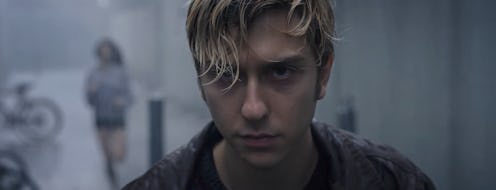
The original manga series Death Note, written and illustrated by Tsugumi Ohba, has been adapted many times over since its release in 2003. There have been anime series, video games, novelizations, mini-series, and, finally, movies. The newest Death Note adaptation from Netflix is a brand new take on the material, and fans who want to compare the new Death Note movie versus the comics will definitely be surprised by the liberties taken in the newest take.
Netflix's live action Death Note movie is not just an adaptation of the manga, but, to quote Lakeith Stanfield, who has a supporting role in the film playing the detective L and recently spoke to Bustle about the movie, it's a "re-imagining." In fact, the movie takes a lot of liberties with the original story while remaining true to the basic plot points. Specifically, the film keeps the same main characters from the original manga. Like the manga, Death Note follows Light (Nat Wolff), a teenager who finds the Death Note, a magical book that allows the owner to kill at will. Ryuk, the demon who comes with the book, also makes an appearance, as does Light's love interest Mia (named Misa in the manga). Finally, L, the detective that is desperate to stop Light and his killing alter ego Kira, is also still present as a pseudo-antagonist. Where the movie really shifts away from the manga is in the details of the plot.
"It's not the Death Note from the anime. We do pay homage to it," Stanfield says. "But I think if you're going into the movie expecting it to mimic the anime, you're going to be disappointed." Stanfield's character L, specifically, has a few differences from his manga origins. L gets a more fleshed out backstory in the film and he's involved in Light's life much earlier in the narrative. This is partly due to the fact that the movie shifts both the setting of the story and the timeline, making it take place over a series of months, not years. Consequently, there's less time to expand on the game of cat and mouse between L and Light, making the entire thing a more straightforward chase.
One of the main differences between the manga and the new movie is the deaths. In the manga, writing a name in the Death Note often results in death by heart attack — an innocuous matter of death that lends a more sneaky aspect to Light's mass murdering alter ego, Kira. In the film, however, the deaths are gruesome, something director Adam Wingard said is meant to reflect the seductive "fun" aspect of the Death Note. "From [Light's] perspective at the beginning of the film, it's very much a fun exciting thing so the deaths are much bigger and operatic," Wingard told /Film.
Fans of the original Death Note manga and anime should be warned that this new movie will be very, very different (especially when it comes to its casting), but it's also supposed to be. Take Stanfield's advice and try not to watch Death Note thinking it will be a classic adaptation. Otherwise, you're just asking to be disappointed.